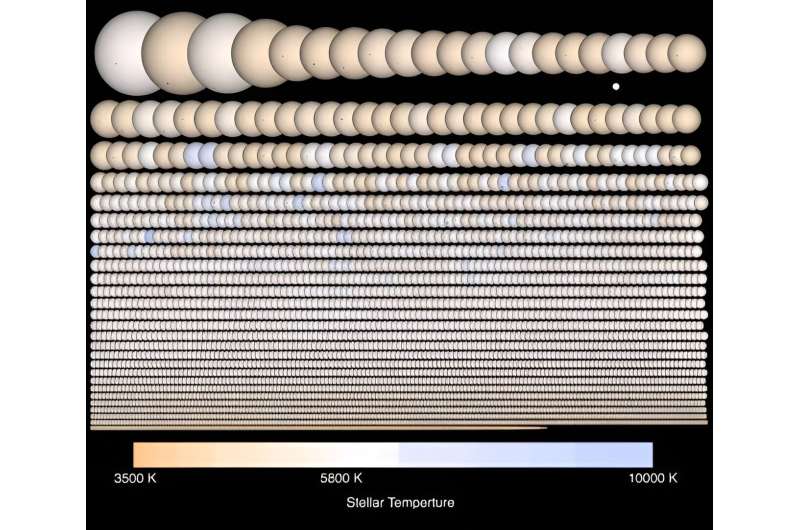This image from the paper is a visual representation of the planets in their abbreviated catalogue, showing planets by size and stellar temperature. Credit: arXiv (2023). DOI: 10.48550/arxiv.2311.00238
NASA's Kepler mission ended in 2018 after more than nine years of fruitful planet-hunting. The space telescope discovered thousands of planets, many of which bear its name. But it also generated an enormous amount of data that exoplanet scientists are still analyzing.
Now, a team of researchers has shed new light on a seven-planet system in Kepler's ocean of data.
The star is called Kepler 385, and it's about 4,670 light-years away. Some of its planets were confirmed back in 2014, while some remained as candidates. But in a new updated catalogue, exoplanet scientists have confirmed the rest of the planets and revealed new details on this rare system.
The paper announcing the new catalogue is called "Updated Catalog of Kepler Planet Candidates: Focus on Accuracy and Orbital Periods." The lead author is Jack Lissauer, a research scientist at NASA's Ames Research Center. The paper will appear in the Journal of Planetary Science and is posted to the preprint server arXiv.
"We've assembled the most accurate list of Kepler planet candidates and their properties to date," Lissauer said. "NASA's Kepler mission has discovered the majority of known exoplanets, and this new catalogue will enable astronomers to learn more about their characteristics."
Scientists have known about the Kepler 385 planetary system for years. Some of its planets were confirmed back in 2014, while others remained candidates. But updated methods and refined data have led to new understandings and discoveries.
The team of researchers behind the catalogue says it lists all known Kepler planet candidates that orbit and transit only one star. One of the most intriguing systems is Kepler 385, which boasts seven planets so close to their star that they're bathed in its heat. All seven are larger than Earth but smaller than Neptune.
Kepler 385 is similar to the sun but a little larger and hotter. It's 10% larger and about 5% hotter. It's one of a very small number of stars with more than six planets or planet candidates orbiting it.
The two innermost planets are both slightly larger than Earth. According to the new catalogue, they're both probably rocky. They may even have atmospheres, though if they do, they're very thin. The remaining five planets have radii about twice as large as Earth's and likely have thick atmospheres.
"Our revision to the Kepler Exoplanet catalogue provides the first true uniform analysis of exoplanet properties," said co-author Jason Rowe, Canada Research Chair in Exoplanet Astrophysics and Professor at Bishop's University in Quebec, Canada. "Improvements to all planetary and stellar properties have allowed us to conduct an in-depth study of the fundamental properties of exoplanetary systems to better understand exoplanets and directly compare these distant worlds to our own solar system and to focus in on the details of individual systems such as Kepler-385."
But the new catalogue is about a lot more than just this rare and interesting system. Kepler 385 is just one of the highlights among the almost 4,400 planet candidates and 700 multi-planet systems in the work.
With improved measurements of the stars that host all these planets —especially from the ESA's Gaia star-measuring spacecraft—the researchers were better able to analyze the distribution of transit durations. Transit durations are an important tool for probing exoplanet distributions. It concerns orbital eccentricities, which range from circular orbits with an eccentricity of zero to highly elongated orbits.
There isn't enough data for most exoplanets to measure their eccentricity individually. But the researchers developed methods that can characterize the distribution of eccentricities for a population of transiting exoplanets. This is an important component of the new Kepler catalogue, and it led the researchers to some new conclusions.
The main one concerns the nature of planetary orbits in multi-planet systems.
"While previous studies had inferred that small planets and systems with more transiting planets tend to have smaller orbital eccentricities, those results relied on complex models," said co-author Eric Ford from the Department of Astronomy and Astrophysics at Penn State University. "Our new result is a more direct and model-independent demonstration that systems with more transiting planets have more circular orbits."
In terms of potential habitability, the Kepler 385 system is a dud.
All seven planets are well inside the habitable zone and bathed in intense radiation. In fact, all seven of them receive more heat from their star per area than any planet in our solar system. But this new work isn't about habitability.
It's about a new Kepler catalogue that's more detailed and accurate than its predecessors.
"It has been more than a decade since Kepler ceased its collection of data from its prime field of view," the authors write. "Nevertheless, the list of Kepler planet candidates remains the largest and most homogeneous collection of exoplanets known."
Now, we have even better data on all those planets. Who knows what other insights it'll generate?
More information: Jack J. Lissauer et al, Updated Catalog of Kepler Planet Candidates: Focus on Accuracy and Orbital Periods, arXiv (2023). DOI: 10.48550/arxiv.2311.00238
Journal information: arXiv
Provided by Universe Today
























